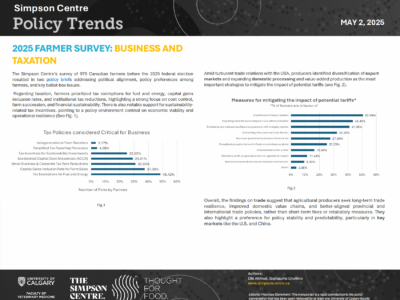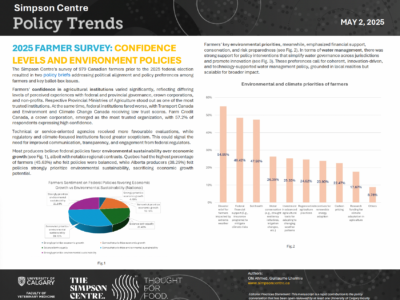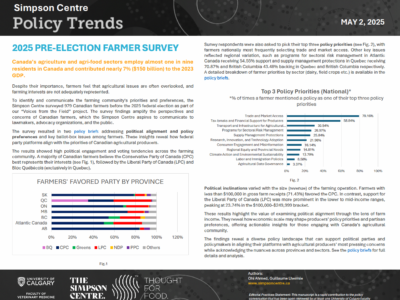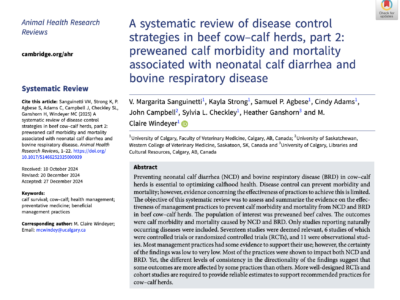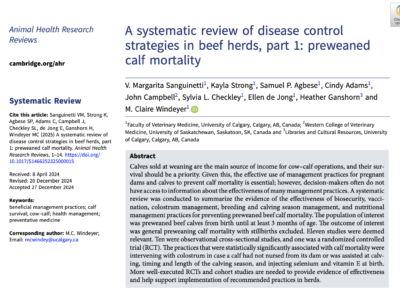Publications
Canadian farmers are calling for tax and trade policies that support long-term business stability, farm succession, and export diversification. The Simpson Centre’s survey also reveals nuanced views on labour and immigration.
Friday, May 02, 2025
Ohi Ahmed and Guillaume Lhermie
The Simpson Centre’s national farmer survey ahead of the 2025 federal election reveals a mixed landscape of institutional trust and environmental policy perceptions across Canada. While farmers place higher confidence in provincial ministries and service-oriented agencies, many express scepticism toward federal regulators and call for more balanced, innovation-driven approaches to environmental and water management.
Friday, May 02, 2025
Ohi Ahmed and Guillaume Lhermie
Ahead of the 2025 federal election, the Simpson Centre surveyed 979 Canadian farmers to better understand their political alignment and top policy concerns. The findings shed light on which federal party farmers believe represents them best, and reveal how farm income, region, and sector shape voting tendencies and policy priorities.
Friday, May 02, 2025
Ohi Ahmed and Guillaume Lhermie
Preventing neonatal calf diarrhea (NCD) and bovine respiratory disease (BRD) in cow–calf herds is essential to optimizing calfhood health. Disease control can prevent morbidity and mortality; however, evidence concerning the effectiveness of practices to achieve this is limited. The objective of this systematic review was to assess and summarize the evidence on the effec- tiveness of management practices to prevent calf morbidity and mortality from NCD and BRD in beef cow–calf herds. The population of interest was preweaned beef calves. The outcomes were calf morbidity and mortality caused by NCD and BRD. Only studies reporting naturally occurring diseases were included. Seventeen studies were deemed relevant, 6 studies of which were controlled trials or randomized controlled trials (RCTs), and 11 were observational stud- ies. Most management practices had some evidence to support their use; however, the certainty of the findings was low to very low. Most of the practices were shown to impact both NCD and BRD. Yet, the different levels of consistency in the directionality of the findings suggest that some outcomes are more affected by some practices than others. More well-designed RCTs and cohort studies are required to provide reliable estimates to support recommended practices for cow–calf herds.
Monday, March 24, 2025
V. Margarita Sanguinetti, Kayla Strong, Samuel P. Agbese, Cindy Adams, John Campbell, Sylvia L. Checkley, Heather Ganshorn, and M. Claire Windeyer
Calves sold at weaning are the main source of income for cow–calf operations, and their sur- vival should be a priority. Given this, the effective use of management practices for pregnant dams and calves to prevent calf mortality is essential; however, decision-makers often do not have access to information about the effectiveness of many management practices. A systematic review was conducted to summarize the evidence of the effectiveness of biosecurity, vacci- nation, colostrum management, breeding and calving season management, and nutritional management practices for preventing preweaned beef calf mortality. The population of interest was preweaned beef calves from birth until at least 3 months of age. The outcome of interest was general preweaning calf mortality with stillbirths excluded. Eleven studies were deemed relevant. Ten were observational cross-sectional studies, and one was a randomized controlled trial (RCT). The practices that were statistically significantly associated with calf mortality were intervening with colostrum in case a calf had not nursed from its dam or was assisted at calv- ing, timing and length of the calving season, and injecting selenium and vitamin E at birth. More well-executed RCTs and cohort studies are needed to provide evidence of effectiveness and help support implementation of recommended practices in herds.
Monday, March 24, 2025
V. Margarita Sanguinetti, Kayla Strong, Samuel P. Agbese, Cindy Adams, John Campbell, Sylvia L. Checkley, Ellen de Jong, Heather Ganshorn, and M. Claire Windeyer
This report evaluates the trends in public and private sector investments in agri-food research from 2013 to 2023, with a focus on identifying funding priorities across key research areas. Additionally, the report examines the alignment of research funding with agriculture programs and frameworks defined by the Canadian government. Specifically, it compares the funding priorities during the Growing Forward 2 (GF2) and Canadian Agriculture Partnership (CAP) periods. These two regimes exhibited distinct research funding trends, and this report evaluates the alignment of these funding trends with the programs and strategies outlined under each regime. The report also provides a jurisdictional scan of Research and Development (R&D) policies and programs in selective OECD countries, as well as trends in expenditure in these countries.
Monday, March 17, 2025
Sabrina Gulab and Guillaume Lhermie
- 1
- 2
- 3
- …
- 15
- Go to Next Page
